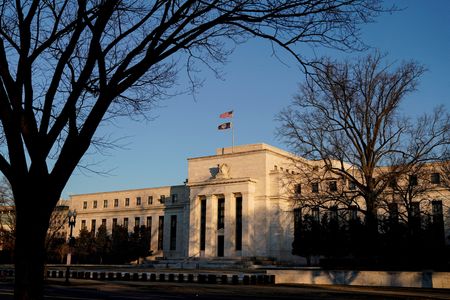By Michael S. Derby
NEW YORK (Reuters) – Top Federal Reserve officials are showing no appetite for slowing the pace of the central bank’s balance sheet reduction, pushing back on outside observers’ assertions that money market conditions will bring an early end to the program.
Fed Chair Jerome Powell and New York Fed President John Williams – whose bank manages the program – this week both said they saw no reason for them to throttle back from allowing about $95 billion a month of Treasuries and mortgage-backed securities to mature to shrink its $8.6 trillion asset portfolio.
The program is part of a broader effort to tighten financial conditions to help arrest the highest level of inflation seen in four decades. The main thrust of that campaign relies on ongoing increases in the Fed’s short-term rate target, with the balance sheet contracting steadily in the background.
Fed officials have not said how far they would like to shrink their holdings or how long the process may take. But some analysts see bank reserve levels falling next year to where the Fed will be forced to slow or even stop the drawdown.
Right now, the banking system is flush with $3 trillion in reserves, down about a $1 trillion from a year ago. And as long as reserve levels are robust, it will allow the Fed’s rate-control toolkit to keep the federal funds target rate range, now at between 3.75% and 4%, at the levels set by the central bank.
But when reserves grow scarce, that can roil short-term rate markets, complicating the conduct of monetary policy.
That happened in September 2019, when the Fed was last shrinking its balance sheet. Then, the Fed was forced to intervene in markets with liquidity injections done through borrowing and buying Treasury securities to restore calm in money markets.
Powell and others do not think that is anywhere near happening yet, though.
“We are not close to reserve scarcity,” Powell said in an appearance Wednesday in Washington.
Williams, speaking to reporters Monday, said his bank is constantly checking with the financial industry to monitor the situation. He noted banks are shedding reserves and appear happy to do so.
Williams added that he was not concerned about a possible short-fall in liquidity due to the just over $2 trillion in cash money market funds and other eligible firms have parked in the Fed’s reserve repo facility. He suggested that’s a pool that can be drawn should any sort of liquidity shortfall develop.
“Everything is working, you know, pretty much as designed,” he said.
That said, Powell suggested the Fed would avoid repeating the 2019 experience when they drew reserves down by too much.
“Demand for reserves, it’s not stable, it can move up and down very substantially. So we want to stop at a place that’s safe,” he said. “It’s really a public benefit to have plenty of reserves, plenty of liquidity in the markets and in the banking system, in the financial system generally.”
(Reporting by Michael S. Derby; Editing by Dan Burns and Stephen Coates)

